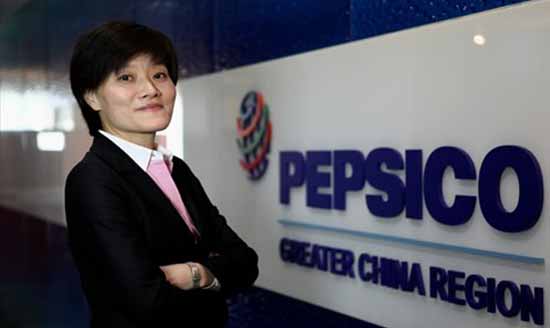

|
 Katty Lam, chairman of PepsiCo Greater China Region? |
PepsiCo entered the China market more than 30 years ago, and has turned from a newcomer to a major player in the country's consumer market. Flush with recent successes from its strong strategy, the international food and beverage conglomerate is confident of business prospects in the world's second largest economy.
"China is one of PepsiCo's most important markets in our global business strategic plans," said Katty Lam, chairman of PepsiCo Greater China Region, in Shanghai recently. "And China is going to have another golden ten years ahead."
Lam - the first-ever Chinese woman to serve as the head of PepsiCo Greater China - was appointed in September this year. Lam is an industry veteran with extensive management experience, who joined the company in 1994.
PepsiCo has had remarkable success with its strategies in China this year. The company has sold a record-high number of potato chips in China, and Lam is confident that its Quaker brand will also become a leader in the oatmeal market in the country next year.
Meanwhile, in the very competitive Chinese beverage market, the Pepsi bottling business outperformed its main competitor in 2013, said Lam.
To increase its share of the non-alcoholic beverage market in China, PepsiCo formed a strategic alliance with China's leading instant noodles and beverages manufacturer Tingyi Holding Corp in 2012. The strong sales network of Tingyi helped PepsiCo distribute beverage products nationwide.
One of the strategies for PepsiCo's success in China lies in developing products that cater to the tastes and preferences of local consumers. To the surprise of PepsiCo headquarters, one of the best-selling potato chip products in China is cucumber flavor, which is not available in other countries.
"We came up with the idea from a common dish in China, paihuanggua (shredded cucumber)," Lam explained.
For a company to do well in the North American market, it only needs to concentrate on one or two popular products, but to succeed in China is a completely different story. "Chinese consumers are experts in food, and they have an appetite for new products. This challenges us to be very creative in product innovation and in trying to satisfy the demands of local consumers," Lam said.
Drawing inspiration from the four famous Chinese regional cuisines, PepsiCo strategically launched four new potato chip families of flavors this year especially for the China market: meat, seafood, spicy and cool.
Endeavoring to develop more new products for China, a new food and beverage innovation center was strategically opened in Shanghai in November last year, PepsiCo's largest research and development center and innovation hub outside of North America.
The top floor of the three-story center is designed for consumer focus groups to discuss ideas. To speed up the process of innovation, any ideas brainstormed by the focus groups will be immediately tested by experts at the lab and the pilot plant downstairs.
"The innovation center can help us better understand the needs of Chinese consumers and develop products that are more locally relevant," said Lam.
PepsiCo's success in China is highly related to its strategic efforts to nurture local talent at all levels, from junior to senior positions. In the past, senior executives’ positions were often filled by foreigners. Now the majority of high-level jobs at PepsiCo are taken up by Chinese, Lam noted.
"Having more Chinese staff at all levels is key to the development of PepsiCo in China," Lam said, revealing that 99.8 percent of staff and 88 percent of senior management in PepsiCo China are Chinese. This shows PepsiCo is at the forefront among multinational companies in China in localizing talent.
Over the past 30 years PepsiCo has invested 15 billion yuan ($2.46 billion) in China. In the future the food and beverage industry leader may develop different products for different regions in China; a strategy that Lam noted will be a trend for the whole consumer industry.